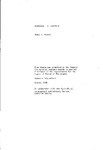DISPERSAL IN CARABIDS
| dc.contributor.author | Newell, Simon C. | |
| dc.contributor.other | Faculty of Science and Engineering | en_US |
| dc.date.accessioned | 2013-11-18T13:06:05Z | |
| dc.date.available | 2013-11-18T13:06:05Z | |
| dc.date.issued | 1986 | |
| dc.identifier | NOT AVAILABLE | en_US |
| dc.identifier.uri | http://hdl.handle.net/10026.1/2725 | |
| dc.description.abstract |
The study consisted primarily of a number of surveys in brassica fields, using pitfall and gutter traps. At all sites a number of different species of carabids were marked and released. From the pitfall trapping it was found that different carabid species inhabitated different parts of the field, particularly in relation to the field boundaries. Two common species, Nebria brevicollis and Bembidion lampros, over-wintered in the hedgebanks, moving out into the fields in the spring. Two other common species, Pterostichus melanarius and Harpalus rufipes, were primarily associated with the field, but activity in the field boundaries continued later into the year. Marking concentrated on four species; P. cupreus, P. melanarius, H. rufipes and N. brevicollis. At all sites the recapture rate of rufipes was much lower than that of P. melanarius, though they are of similar size. Using this data, mean displacement/day was calculated for each species. To identify the causes for the differences in recapture rate between the species, two species were individually tracked at night, in the field. Positions every two minutes were recorded and the distance and turn between each point measured. The results showed that H. rufipes had a higher turn rate and moved less than melanarius. The data from tracking was incorporated into a computer simulation model which recreated the beetles' tracks, using the same time interval. Traps were added and the model used to simulate the recapture experiments in the field. Changes in dispersal patterns were used to create differences in the catch in different patches. It was found that changes in turning behaviour could not produce changes in density, because of behaviour at the boundaries. Delaying the change in behaviour produces differences in numbers, but orientation is the most likely mechanism. The relationship between step length, turn and catch was also evaluated. | en_US |
| dc.description.sponsorship | The Agricultural Development and Advisory Service, Starcross, Devon | en_US |
| dc.language.iso | en | en_US |
| dc.publisher | University of Plymouth | en_US |
| dc.title | DISPERSAL IN CARABIDS | en_US |
| dc.type | Thesis | |
| plymouth.version | Full version | en_US |
| dc.identifier.doi | http://dx.doi.org/10.24382/1479 |
Files in this item
This item appears in the following Collection(s)
-
01 Research Theses Main Collection
Research Theses Main


